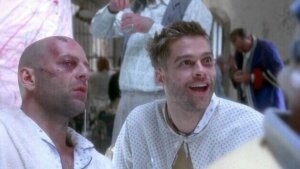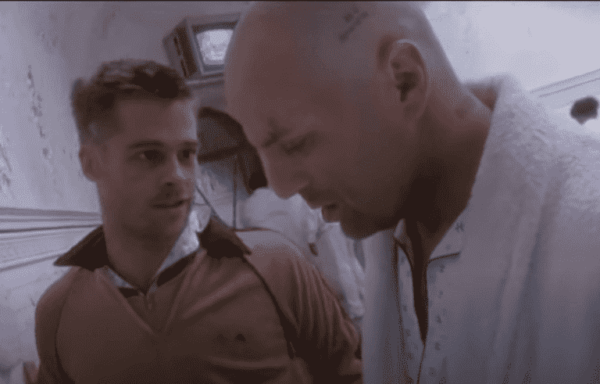12 Monkeys: A Dystopia For Modern Times


Written and verified by the film critic Leah Padalino
Truth can be stranger than fiction. As a matter of fact, this phrase has never made as much sense as it does now. After all, just a few years ago, most of us would never have believed the situation we’ve been through over the past two years. However, the film, 12 Monkeys predicted some of our current reality.
Truth has become so much stranger than fiction that dystopian stories are no longer even surprising. As a matter of fact, Charlie Brooker, the creator of Black Mirror, has decided not to continue his series. Nevertheless, regardless of the circumstances, it’s interesting to take a look back at some of the movies that seemed to predict what was coming our way.
From the 90s, 12 Monkeys is a film that warned of an inhospitable future as a result of a virus (Gillian, 1995).
12 Monkeys: Dystopian Sci-Fi
Dystopia is a branch of science fiction. It warns us about a bleak, inhospitable future. A fictional future that’ll arise due to the consequences of the present if we don’t take the necessary actions to avoid them.
Dystopia became a prominent genre in the late 20th and 21st centuries. Some of these works seem to predict the negative consequences of unprecedented technological advancements.
12 Monkeys and the present
Today, 12 Monkeys appears far more real than could ever have been expected. In fact, it portrays a future where humanity has to live underground as a result of a virus, making it eerily applicable to the world today.
Filmmaker Terry Gilliam, the creator of the successful Monty Python series, took inspiration from the French film La Jetée (Marker, 1962) in creating 12 Monkeys.
Bruce Willis shines in the title role. He portrays a man born in the late 80s who sees the world he knew vanish due to a virus. Forced to live underground with everyone else, he’s sent on a series of missions to try and fix past mistakes. His aim is to discover the origin of the virus and get samples in order to allow scientists to develop a vaccine.
Playing the antagonist is a young Brad Pitt, who, at the time wanted to disassociate himself with the role of the ‘pretty boy’. In this film, he gives a terrific interpretation of madness.
The underworld that James Coles (Bruce Willis) inhabits is grimy, dark, inhospitable, and gloomy. In fact, the staging is as distinctive as the filmmaker himself.
Science fiction is more than just machinery and space travel. It also incorporates travel to the past (or present) from an agonizing, dark perspective. However, the message is clear. The future could be terrifying if action isn’t taken.
Rather than focusing on special effects, Gilliam opts for a thriller-like feel to this film. The protagonist has to unravel everything that led up to the present in order to get a cure or stop the progress of the virus.
Typical of the genre of dystopia, this film leaves us with an ambiguous ending. At the same time, it conveys the idea that the inevitable is stronger than any scientific or technological advancements.
Portraying madness
This film looks at humans through the lens of a madhouse. Brad Pitt, (Jeffrey Goines) takes the lead in these scenes. Furthermore, subjecting the hero, James Cole, who’s been sent back from the future, to madness, provides an interesting take on humans as a species.
Similarly, the asylum is depicted as completely chaotic. A place that keeps everyone outside the norm and completely separate from society.
As viewers, we know that James Cole is sane but the world doesn’t see him that way. As a consequence, he’s thrown into an environment that’s almost more inhospitable and chaotic than the apocalypse itself.
The idea of the exclusion of the ‘madman’ is reminiscent of Michel Foucault and his book, The History of Madness. In this work, he observed how the definition of the ‘madman’ has changed over time yet they still appear to be doomed to exclusion.

No solution
Finally, despite Cole’s time travel and multiple attempts to change the past, the message of 12 Monkeys is clear. There’s no solution. Even trying to change the past doesn’t work because history simply repeats itself on a cyclical basis.
For some reason, humanity has been condemned to suffer the consequences of the virus. Therefore, the only solution is to find a vaccine or a drug that can cure the disease.
It’s interesting to consider the role of the female in the film, from a current perspective. Dystopia is a genre that often tends to punish women enormously. For example, in The Handmaid’s Tale or V for Vendetta. The woman, frequently excluded, seems to find herself in a position of greater vulnerability in the dystopian society.
In 12 Monkeys, the only relevant female character is that of Dr. Railly, a psychiatrist who helps Cole. However, it’s striking that her character is built around a man. A man who kidnaps her and with whom she finally ends up falling in love. Nevertheless, this movie was made in the 90s when these types of stories were the order of the day. Therefore, it’s not worth questioning them.
This is a movie that tells a story of despair and leaves us with a bittersweet taste. In fact, it tells us that there’s no solution. Thus, humanity appears to be doomed to disaster. They’re all locked away underground due to an invisible enemy. The same kind of enemy that has kept us locked away over the past couple of years.
This text is provided for informational purposes only and does not replace consultation with a professional. If in doubt, consult your specialist.








